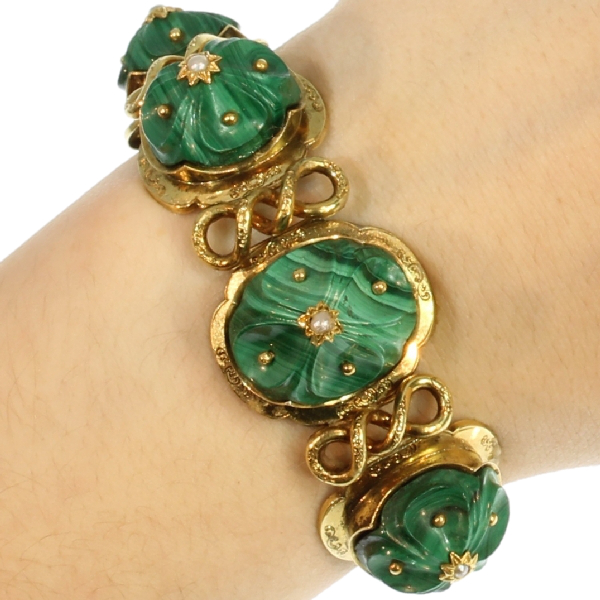We offer layaway, spread payments on the piece of your dreams. Ask us for details. Free insured shipping on all orders !!!
Russian malachite articulated bracelet
Every of the seven decreasing malachite ovals of this Russian Victorian bracelet from 1830 rests in a quatrefoil setting, which emphasizes the four engraved leafs blossoming from a central seed pearl. With the engraved frills and with a gold dot in each leaf, it's clear that the closed double helix links connect fragments of pure luck materialized in green domes.
Antique jewelry object group: bracelet
Country of origin:
Although it does not carry any recognizable control marks we think that the bracelet of Russian origin
Style:
Victorian - Victorian decorative arts refers to the style of decorative arts during the Victorian era. The Victorian era is known for its eclectic revival and interpretation of historic styles and the introduction of cross-cultural influences from the
middle east and Asia in furniture, fittings, and Interior decoration. Victorian design is widely viewed as having indulged in a regrettable excess of ornament. The Arts and Crafts movement, the aesthetic movement, Anglo-Japanese style, and Art Nouveau
style have their beginnings in the late Victorian era.
See also: Victorian
or more info on styles
Period: ca. 1830
(events and facts in 1830)
Material: 18K yellow gold
(more info on precious metals)
Technique: high domed sculpturing/stone engraving
Extra information:
Malachite - The stone's name derives (via Latin: "molochitis", Middle French: "melochite", and Middle English "melochites") from Greek "molochitis lithos", "mallow-green stone". The mineral was given this name due to its resemblance to the leaves of
the Mallow plant.
Malachite was used as a mineral pigment in green paints from antiquity until about 1800. The pigment is moderately lightfast, very sensitive to acids and varying in color. The natural form was being replaced by its synthetic form, verditer amongst other
synthetic greens. It is also used for decorative purposes, such as in the Malachite Room in the Hermitage, which features a large malachite vase. "The Tazza", one of the largest pieces of malachite in North America and a gift from Tsar Nicholas II,
stands as the focal point in the center of the room of Linda Hall Library.
Archeological evidence indicates that the mineral has been mined and smelted at the site for over 3,000 years. In Israel, malachite was extensively mined at Timna valley, often called King Solomon's Mines, although research has revealed an interruption
in mining activity at the site during the 10th century BC, the time of the biblical Solomon.
Large quantities of malachite have been mined in the Urals, Russia. It is found worldwide including in the Democratic Republic of Congo; Zambia; Tsumeb, Namibia; Mexico; Broken Hill, New South Wales; Lyon, France; and in the Southwestern United States
notably in Arizona. (from: Wikipedia)
Precious stones:
Seven malachites and
seven seed pearls.
(more info on precious stones)
Hallmarks: The only hallmark we found is in a rectangular shape and has the letter "V" and something that resembles an "eight" (see also the picture we took)
(more info on hallmarks)
Condition: excellent condition
(more info on our condition scale)
Dimensions: length 18.00 cm (7.09 inch)
Weight: 51.40 gram (33.05 dwt)
Reference Nº: 10266-4317
Copyright photography: Adin, fine antique jewelry
See also our:
bracelets,
bangles,
yellow gold jewelry,
latest acquisitions,
antique jewelry,
estate jewelry,
vintage jewelry or
modern jewelry
Jewelry with birthstones (or month stones) for:
January -
February -
March -
April -
May -
June -
July
August -
September -
October -
November or
December.
Additional information:
jewelry glossary -
wall of fame -
visit us in Antwerp -
subscribe to our mailinglist.
What is antique jewelry? -
What is estate jewelry? -
What is vintage jewelry?




